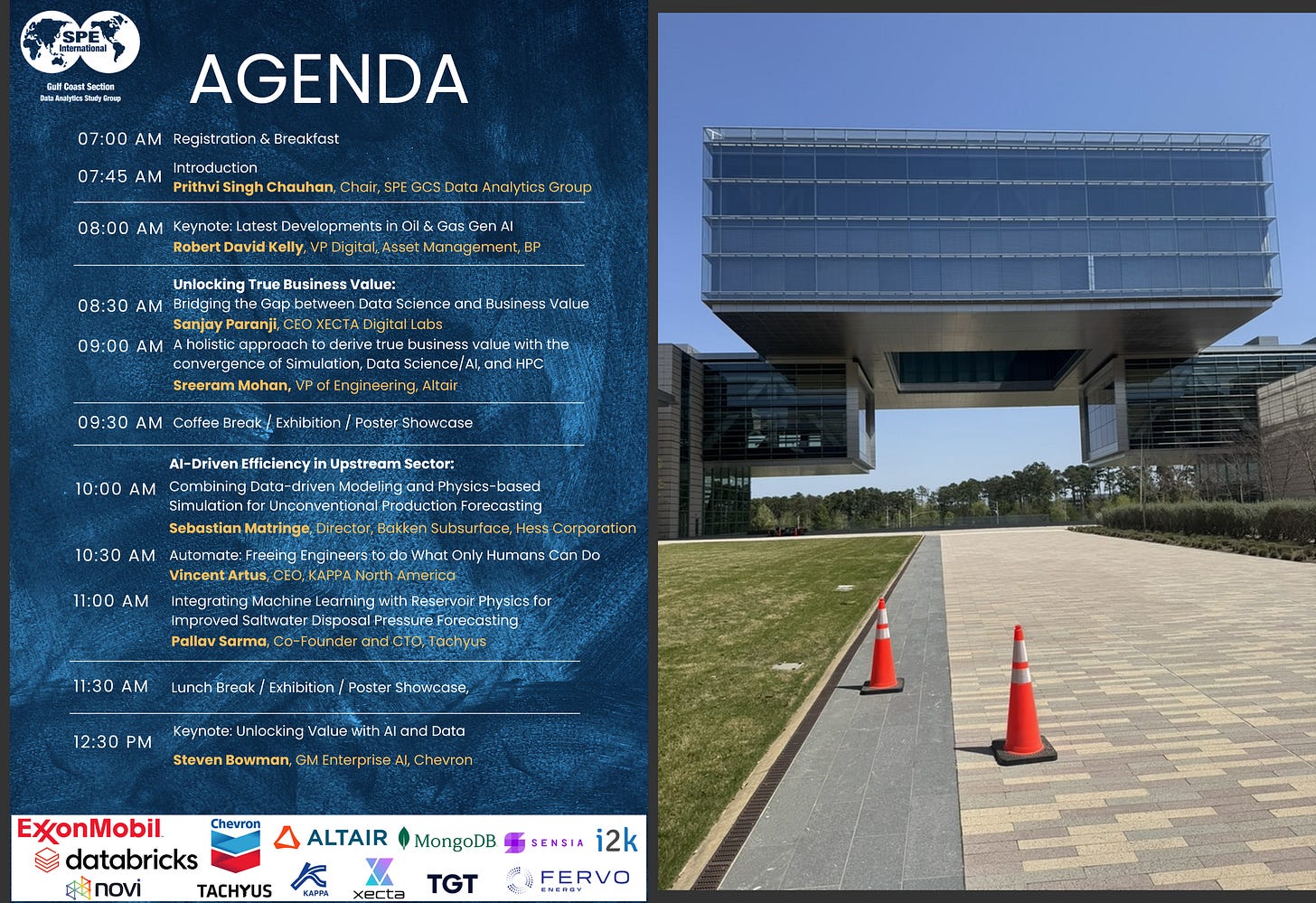Why do Digital Transformation Projects Fail?
Answering one of the biggest questions from a recent SPE conference
Background
Last Friday, I had the privilege of attending the SPE Data Science Convention at ExxonMobil's campus. As an engineer, data scientist, AND someone that works in the oil and gas industry, this was the epitome of a 'good time' for me. It was also my first opportunity to personally step foot on ExxonMobil's relatively new campus, despite having seen countless pictures of the now famous architecture.
Listening to several of the talks (which were all quite good), I was struck by a question that seemed to be repeated by a few speakers in some form or another:
“We want to understand why some digital transformation projects fail while others succeed?”
As an industry that routinely designs and executes multi-billion dollar projects with success, this question feels odd. We are openly admitting failure - and not just one failure, but multiple failures that seem to be a theme across the industry.
At Pontem, we are careful with the term "digital transformation" because it can often be a bloated buzzword that lacks tangible meaning. Despite this, many of the solutions we provide would be classified under that banner.
To try and provide our own perspective on this question, I consulted several of my colleagues who are actively building out our strategy around data and digital. Here are their answers:
Abhinav’s Answer
There’s no shortage of research highlighting why digital transformation projects fail—Gartner, Verdantix, and others have pointed out familiar patterns: unclear goals, lack of alignment, and poor adoption. But beyond the reports, personal experience has been the clearest teacher.
I’ve seen both ends of the spectrum. One example that stands out is a failed initiative to build a multi-million (20M+) multi-year (5+) digital twin project . There were plenty of use cases thrown around—on paper, it all looked ambitious and exciting. The problem? It was entirely top-down. Management consultants came in with a “Big Data and AI” directive without engaging with the actual operations teams. There was no real understanding of the day-to-day challenges on the ground. This led to the wrong platforms being applied, vague data priorities, and ultimately poor adoption. Value creation never materialised because the solutions weren’t grounded in operational reality.
Contrast that with a more successful approach: projects where we’ve been involved from the EPC stage. In those, there was early alignment on digital deliverables—engineering data and documents were delivered in formats like CIHIFOS that actually enabled downstream integration. Clear requirement specifications were defined up front. We took a domain- and data-led approach, focusing on high-value use cases and leveraging physics-informed ML to reduce complexity and cost. This approach is nimble, scalable, and grounded in actual business needs. Adoption follows naturally because users see the value from the start.
A few lessons have become clear over time:
Skin in the game is essential—not just from IT, but from ops, engineering, and leadership.
Define specs early—vagueness at the start leads to chaos down the line.
Under-promise and over-deliver—build momentum with small wins rather than overwhelming the business with moonshots.
Digital transformation isn’t a magic switch. It’s a process of aligning the right people, solving real problems, and choosing the right time to scale. And when done right, the results can be truly transformative—not because of the buzzwords, but because of the value delivered on the ground.
Ian’s Answer
Digital transformation, or even using the term digital can be a ‘catch all’ term with a lack of definition. When I was growing up the buzzword was the same and just as broad.
In the 80s and early 90s "digital" primarily referred to technologies and devices that used digital signals (0s and 1s) instead of analog signals. It was a transformative period as many industries shifted from analog to digital systems, and the word "digital" became synonymous with cutting-edge, futuristic, and efficient technology (just like today), but the use was as broad then as it is now. I am sure everyone of my age can remember the crystal clear sound of listening to their first CD, Casio watches, the first 8-bit video games consoles and the vivid colours (when Mario was really Mario), the end of verbal communication with the first text messages, the end of Kodak with the digital camera and the emergence of digital TVs.
Digital was the buzzword for progress, symbolizing the shift from unreliable analog devices to sleek, precise digital ones. Is this any different today?
In the present day the key to achieving a successful transformation is to consider the actual real life application of technologies to build targeted use cases in a way that enables scaling and diversification across the business. By targeted this means identifying the issues and applying domain expertise to understand the problem (whatever that may be from engineering to data science, IT, shipping logistics….anything!) and then apply the data and digital knowledge to construct specific applications to solve and optimise operations and processes to add value and reduce cost.
Whilst a top down digital transformation directive will support this approach by providing development platforms and workflows, it is often convoluted in communication and application and hence rarely add the value on the ground in operation and projects. This is where the expertise to understand the problem and use the data pipelines to access the right data to correctly to build a solution is required. The value created is so much more that just dashboarding and visualisation.
This is the approach Pontem have adopted take to provide domain led digital transformation solutions to our clients, using our expertise in domain and data to provide value.
For those who remember the initial days of text messing on mobile phones: 844266557777033366677707773323444664
My Answer
Having heard from Ian / Abhinav, I’ll take my own crack at the question as well, albeit keeping it short and simple:
Some digital transformation projects fail because some projects are not made for large scale, sweeping digital overhauls despite best intentions. My feeling, and it aligns with the approach we take at Pontem, is that starting with specific areas to target and working from a bottom up approach as opposed to a top down approach is the only way to guarantee success. Being open and realistic about expectations and goals will prevent “failures”.
P.S. I do also believe there is a tendency in the industry for executives and managers to overpromise on what AI can deliver and that is a non-trivial component of these failures. Fundamentally if you have never carried out a data analysis exercise or built a neural network, then the concept of AI will be a high-level one for you and that will naturally propagate into how you speak and act in relation to it. The best managers I’ve had in my career have been ones that have carried out the exact tasks they have asked me to do and I think this same philosophy should apply to digital transformation.






Top down vs bottom up...
May the front line users be the champions of the project (those who really deal with the problem) the success will be at your fingertips